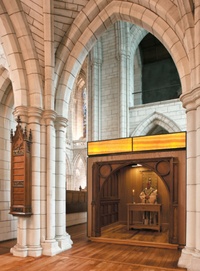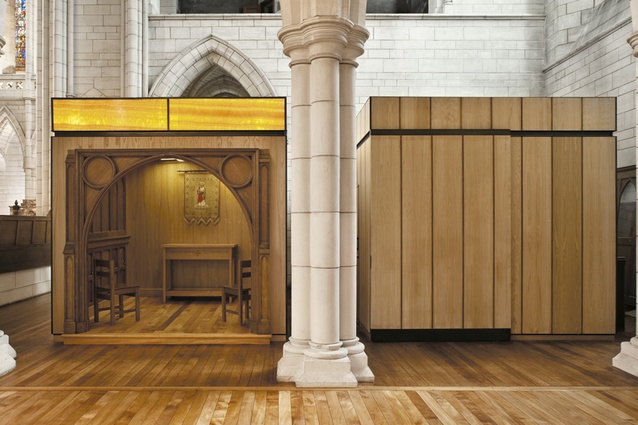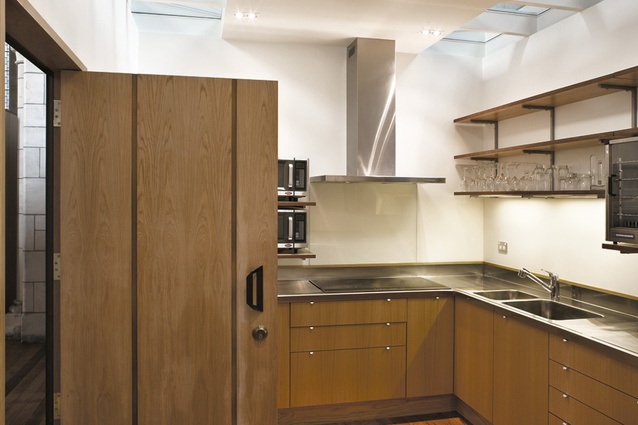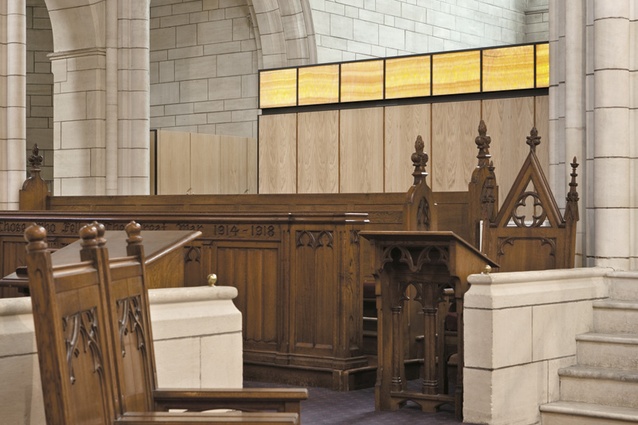Salmond Reed Architects add compact cubes to Auckland church
Auckland's St Matthew-in-the-city has welcomed a new chapel and kitchen designed by Salmond Reed Architects.
This must have been an interesting commission: reintroduce historical fabric into a much-admired heritage building, accommodate sacred and profane functions within distinct but related containers, and respond to the architectural context in a manner that is sympathetic but not imitative.
St Matthew-in-the-City is the home of a historic Anglican parish with a very modern outlook on life and liturgy. Within the southern transept of a 1905 Gothic Revival church Peter Reed has inserted two structures that contain a chapel dedicated to St Thomas and back-to-back kitchen and toilet facilities. Subsidiary to these cubes are a vestments store and sacristy, which are neatly tucked away from view.
Back in May the new chapel and kitchen cubes were somewhat overwhelmed by protective packaging and scaffolding as St Matthew’s new Willis organ from Liverpool was being installed. Once these distractions have been removed, the clarity and simplicity of Reed’s design will be revealed.
The story of the chapel cube begins with the Southern Cross V, a Melanesian Mission ship that serviced the Pacific in the early twentieth century. When the ship capsized, the chapel panelling was rescued from the Waitemata Harbour by the Anglo-Catholic priest then stationed at St Thomas’s Church, Freemans Bay. St Thomas’s was an outpost of St Matthew’s and so, after it was demolished, the panelling was rescued once more and installed in a room beneath St Matthew’s. Here it was reconfigured to serve as an auxiliary chapel.

The ship’s chapel has now been fully revived as a side chapel and the panelling carefully reassembled. The curved ceiling and floor speak to the chapel’s nautical origins, and the historical association between the church and chapel ensure that recycling some wood found in the basement is no empty gesture. At present the chapel looks somewhat austere, but in time it is to be hoped that the rich ornamentation seen in historical photographs of the Southern Cross will further enhance the jewel-box quality of the sacred cube.
Crowned by glowing lightboxes, the chapel quietly asserts its dominance over the “profane” kitchen/toilet cube beside it. Separated by a narrow passageway, each cube is clad in pale oak. In true Arts and Crafts fashion, the vertical panelling of the cubes contrasts with the horizontal coursing of the church’s Oamaru stone walls and vaults. The appropriateness of vertical timber elements (trees grow up) in combination with horizontal stone ones (stone is laid down) would read as a cliché if it didn’t make sense. The vertical panelling also goes some way to alleviating the potential for the cubes to look squat, particularly when seen from the choir stalls in the chancel. That said, the southern transept housed the organ console until recently and so the flat-roofed cubes now offer a more generous view of the vault than was previously available.
With the former church kitchen taken over by the mechanics of the new organ, the new kitchen and disabled-toilet cube will bring these practical amenities closer to the congregation and the church’s other users. The church is large enough to absorb what some might see as an intrusion. As both cubes touch the building very lightly the possibility that they are temporary structures hovers over them. Nonetheless, the restrained elegance of the cubes’ design and the anchoring weight of the chapel’s history make them worthy additions to a heritage building that is itself a container for both tradition and innovation.













